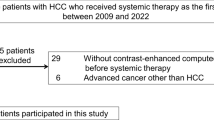Abstract
Neuroendocrine tumors (NETs) of the gastrointestinal tract have a propensity for hepatic metastases. Surgical resection for hepatic metastases remains the gold standard for long-term survival, but many patients present with multifocal tumors, precluding surgery with increasing use of chemoembolization. However, there are few studies examining long-term survival factors. We reviewed our 15-year experience with chemoembolization in 123 patients with unresectable NET liver metastases, whose prognosis was evaluated upon baseline clinical factors. There were 64 males (53%) and 59 females (47%). Average age at presentation was 56 years (range: 14.3–85.5 years). Abdominal pain (44%) was the most common presenting symptom, followed by diarrhea (30%) and weight lost (22%). Patients underwent an average 7.3 cycles of chemoembolization (range 1–32 cycles). Responses: 62% of patients had PR; 24% had stable disease and 14% had tumor progression. Overall 3-, 5- and 10-year survivals were 59, 36 and 20% of patients with a mean follow-up of 3.2 years (range 2 weeks–18.3 years) and mean survival of 3.3 years. Univariate analysis showed that age greater than 60 years had worse outcome (P < 0.01), as did baseline serum albumin of ≤3.5 g/dL and prothrombin time >13 s. Location of the primary tumor (P = 0.68), gender (P = 0.4) and serum NET peptide levels did not influence survival. However, multivariate analysis showed that a low baseline serum albumin level was an independent factor for prognosis (P = 0.003). Chemoembolization for unresectable NETs metastatic to liver is useful for tumor size reduction, symptom palliation and can be associated with prolonged survival.
Similar content being viewed by others
Abbreviations
- NET:
-
Neuroendocrine tumor
- CT:
-
Computerized tomography
- PR:
-
Partial response
References
O’Toole D, Maire F, Ruszniewski P. Ablative therapies for liver metastases of digestive endocrine tumours. Endocr Relat Cancer. 2003;10:463–8.
Creutzfeldt W. Carcinoid tumors: development of our knowledge. World J Surg. 1996;20:126–31.
Lips CJ, Lentjes EGWM, Hoppener JWM. The spectrum of carcinoid tumours and carcinoid syndromes. Ann Clin Biochem. 2003;40:612–27.
Moertel CG. Karnofsky memorial lecture: an odyssey in the land of small tumors. J Clin Oncol. 1987;5(10):1503–22.
Berge T, Linell F. Carcinoid tumors, frequency in a defined population during a 12-year period. Acta Pathol Microbiol Scand A. 1976;84:322–30.
Bax N, Woods H, Batchelor A, Jennings M. Clinical manifestations of carcinoid disease. World J Surg. 1996;20:142–6.
Proye C. Natural history of liver metastasis of gastroenteropancreatic neuroendocrine tumors: place for chemoembolization. World J Surg. 2001;25:685–8.
Shebani KO, Souba WW, Finkelstein DM, Stark PC, Elgadi KM, Tanabe KK, et al. Prognosis and survival in patients with gastrointestinal tract carcinoid tumors. Ann Surg. 1999;229(6):815–23.
Pape U-F, Bohmig M, Berndt U, Tiling N, Wiedenmann B, Plockinger U. Survival and clinical outcome of patients with neuroendocrine tumors of the gastroenteropancreatic tract in a German referral center. Ann N Y Acad Sci. 2004;1014:222–33.
Woodside KJ, Townsend CM, Evers BM. Current management of gastrointestinal carcinoid tumors. J Gastrointest Surg. 2004;8(6):742–56.
Yao KA, Talamonti MS, Nemcek A, Angelos P, Chrisman H, Skarda J, et al. Indications and results of liver resection and hepatic chemoembolization for metastatic gastrointestinal neuroendocrine tumors. Surgery. 2001;130(4):677–85.
Siperstein AE, Berber E. Cryoablation, percutaneous alcohol injection, and radiofrequency ablation for treatment of neuroendocrine liver metastases. World J Surg. 2001;25(6):693–6.
Florman S, Toure B, Kim L, Gondolesi G, Roayaie S, Krieger N, et al. Liver transplantation for neuroendocrine tumors. J Gastrointest Surg. 2004;8(2):208–12.
Azimuddin K, Chamberlain RS. The surgical management of pancreatic neuroendocrine tumors. Surg Clin North Am. 2001;81(3):511–25.
Sutcliffe R, Maguire D, Ramage J, Rela M, Heaton N. Management of neuroendocrine liver metastases. Am J Surg. 2004;187:39–46.
Chamberlain R, Canes D, Brown K, Saltz L, Jarnagin W, Fong Y, et al. Hepatic neuroendocrine metastases: does intervention alter outcomes? J Am Coll Surg. 2000;190(4):432–45.
Nave H, Mossinger E, Feist H, Lang H, Raab H-R. Surgery as primary treatment in patients with liver metastases from carcinoid tumors: a retrospective, unicentric study over 13 years. Surgery. 2001;129:170–5.
Roche A, Girish BV, de Baere T, Baudin E, Boige V, Elias D, et al. Trans-catheter arterial chemoembolization as first-line treatment for hepatic metastases from endocrine tumors. Eur Radiol. 2003;13:136–40.
Allison D, Modlin I, Jenkins W. Treatment of carcinoid liver metastases by hepatic-artery embolisation. Lancet. 1977;2(8052–8053):1323–5.
Drougas JG, Anthony LB, Blair TK, Lopez RR, Wright JK, Chapman WC, et al. Hepatic artery chemoembolization for management of patients with advanced metastatic carcinoid tumors. Am J Surg. 1998;175:408–12.
Carr BI, Kondragunta V, Buch S, Branch R. Therapeutic equivalence in survival for hepatic arterial chemoembolization and 90Yttrium microspheres (Y90) treatments in unresectable HCC. Cancer. 2010;116:1305–14.
Gupta S, Yao JC, Ahrar K, Wallace MJ, Morello FA, Madoff DC, et al. Hepatic artery embolization and chemoembolization for treatment of patients with metastatic carcinoid tumors: the M.D. Anderson experience. Cancer J. 2003;9(4):261–7.
Vogl TJ, Gruber T, Naguib NNN, Hammersting R, Nour-Eldin NA. Liver metastases of neuroendocrine tumors: treatment with hepatic transarterial chemotherapy using two therapeutic protocols. Am J Roentgen. 2009;193:941–7.
Carr BI, Buch SC, Kondragunta V, Pancoska P, Branch RA. Tumor and liver determinants of prognosis in unresectable HCC: a case cohort study. J Gastroenterol Hepatol. 2008;23:1259–66.
Author information
Authors and Affiliations
Corresponding author
Rights and permissions
About this article
Cite this article
Dong, X.D., Carr, B.I. Hepatic artery chemoembolization for the treatment of liver metastases from neuroendocrine tumors: a long-term follow-up in 123 patients. Med Oncol 28 (Suppl 1), 286–290 (2011). https://doi.org/10.1007/s12032-010-9750-6
Received:
Accepted:
Published:
Issue Date:
DOI: https://doi.org/10.1007/s12032-010-9750-6




